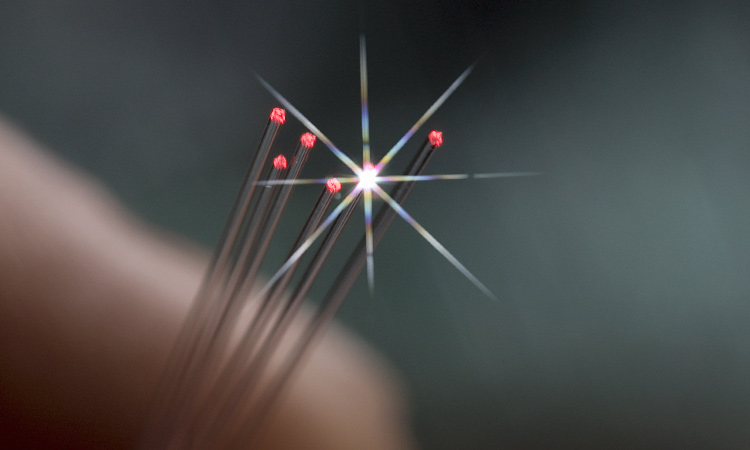 [Getty Images]
[Getty Images]
Robert Maurer didn’t know much about communications in 1966 when William Shaver began talking about an idea he’d garnered while visiting the British Post Office Research Laboratory in London. The Post Office wanted to run telephone signals through glass fibers, and Maurer and Shaver worked at the Corning Glass Works—a company in the business of inventing glass for new applications. It would be a fertile combination.
After working as a physicist on projects from Pyrex cookware to casting Palomar Telescope’s 200-inch mirror, Shaver was searching the world looking for new glass ideas for Corning to develop as he neared retirement. At the cutting edge of Britain’s civilian and military telecommunications, the Post Office Lab was intrigued by Charles Kao’s idea that ultra-clear glass fibers could carry signals many kilometers (see OPN, March 2019, The Remarkable Fiber Optic Vision Of Charles Kao).
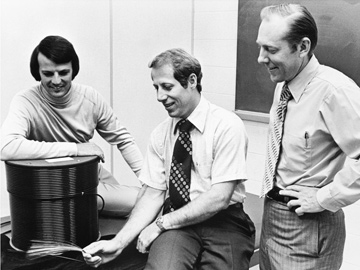 Peter Schultz (left), Donald Keck and Robert Maurer pose at Corning with the first optical cable made for communications, under a contract from the Naval Electronics Command in San Diego, CA, USA. [Corning Inc., courtesy AIP Emilio Segrè Visual Archives, Hecht Collection]
Peter Schultz (left), Donald Keck and Robert Maurer pose at Corning with the first optical cable made for communications, under a contract from the Naval Electronics Command in San Diego, CA, USA. [Corning Inc., courtesy AIP Emilio Segrè Visual Archives, Hecht Collection]
Corning already made bundled fiber optics for medical and military use, but the light paths were no longer than a couple of meters, with losses of a decibel per meter. Kao’s plan needed fibers with losses of 20 decibels per kilometer, to carry signals roughly 10 km. That would require reducing loss by 980 dB/km—a forbiddingly large factor of 1098. Research director Bill Armistead liked the idea, but assigned it to the fundamental-physics research group that Maurer headed. “There was no great urgency,” recalls Maurer.
Maurer had joined Corning in 1952 with a Ph.D. in low-temperature physics from the Massachusetts Institute of Technology, USA, and became a glass expert by doing fundamental research on the nature of glass. Theory considered glass as a liquid with atoms frozen in random positions, uniform except for small, random microstructures. Yet many measurements showed 10 to 100 times more scattering than expected. Maurer showed that light scattering varied little with angle, supporting the frozen-liquid theory. His results in the December 1956 Journal of Chemical Physics initially were controversial, but they proved correct, and Kao cited them in his own 1966 landmark paper.
Seeking the purest glass
Fiber communication’s two main challenges were making glass so pure it absorbed or scattered very little light, and drawing it into light-guiding fibers with a high-index core and a lower-index cladding. There were two possible starting points: well-developed optical glasses that required extensive purification; or fused silica (SiO2), which was extremely pure but had to be melted at very high temperatures and had such a low refractive index that the fiber core would have to be alloyed with a high-index material.
Fiber communication’s main challenges were making glass so pure it absorbed very little light, and drawing it into light-guiding fibers with a high-index core and lower-index cladding.
“Most talk was how to purify the raw materials used to make meltable glasses,” recalls Maurer. Starting with optical glass seemed the obvious choice; plenty of glass compositions were available for use as core and cladding, as were ovens for melting it.
“That was one of the reasons I started with silica,” says Maurer. “I had no reason to think it was any better, but nobody else was working on it.” His strategy was deliberately contrarian. “If you do something that is different from what everybody else is doing, you’ve got two advantages. One is you may succeed where they fail, of course, but even if you fail you will gather information that they don’t gather,” he said in a 1995 interview.
 Frank Hyde at work in his lab circa 1934. [Courtesy of Corning Inc.]
Frank Hyde at work in his lab circa 1934. [Courtesy of Corning Inc.]
Corning also had already developed fused silica for applications that took advantage of its low thermal expansion. The company had used a borosilicate glass, Pyrex, to cast the 200-inch Palomar mirror in the early 1930s. Pure silica had even lower thermal expansion, but no process existed to make it in quantity until a young chemist, J. Franklin Hyde, squirted liquid silicon tetrachloride into an oxy-hydrogen flame to yield a powdery white “soot” that was pure SiO2. The purity came from the raw materials reacting to make silicon tetrachloride, which evaporated at 58 °C, leaving all the impurities behind.
The invention came too late to use in a telescope. But when Corning needed a strong high-temperature ceramic in the 1950s, it blended Hyde’s fused silica with titania for use in ceramic CorningWare cookware, spy-satellite mirrors and missile nose cones.
A slow start
The same materials were available when Maurer got a small budget to spend time studying fibers. The job got off to a slow start. After some investigation, he decided to make a single-mode fiber with help from Frank Zimar, a Ph.D. experimental chemist in the development group who had joined Corning in 1945. Zimar had built a furnace for an earlier semiconductor project that could handle materials at temperatures higher than 2000 °C, well above the 1650 °C needed to soften fused silica. It was the only furnace at the research center that could reach those temperatures, and Zimar was the only one who knew how to run it.
Maurer and Zimar made their first single-mode fiber by machining a rod from titanium-doped silica, inserting it into a hole machined in pure silica, and placing it in Zimar’s furnace to draw a fiber. “It was terrible as you might imagine,” Maurer recalls. But it showed that fused silica could be drawn into a fiber.
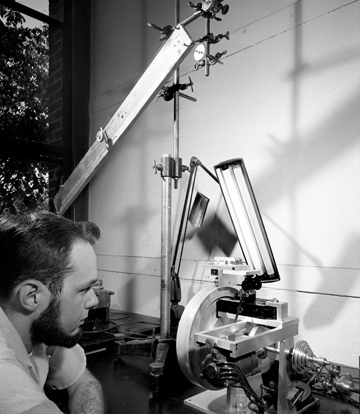 Physics student Lawrence Curtiss demonstrates production of the rod-in-tube process he invented for the fiber optic gastroscope in June 1957. [Bentley Historical Library, University of Michigan]
Physics student Lawrence Curtiss demonstrates production of the rod-in-tube process he invented for the fiber optic gastroscope in June 1957. [Bentley Historical Library, University of Michigan]
In 1967, a summer intern, Clifton Fonstad, made scattering measurements and worked with Zimar to draw single- and multimode fibers from silica rods and tubes. The attenuation was high, but the results were more encouraging than Maurer had expected. He convinced Amistead to expand silica fiber research beyond a side project for him and Zimar.
The first step was assigning 10% of Peter Schultz’s time to the fiber project. Schultz had joined Corning in July 1967 after receiving a doctorate from Rutgers University, NJ, USA for developing an opaque glass laden with iron and lithium for use in computer memories. Schultz started by studying Hyde’s flame hydrolysis work and building a furnace for making and testing fused silica.
Maurer also went recruiting new Ph.D.s, at a time when the physics job market was red hot. At Michigan State University, USA, he found Donald Keck, who was intrigued by wave propagation, and lured him to Corning with the chance to develop waveguides for light.
Better ways to draw fibers
After Keck arrived in January 1968, he and Schultz tried drawing rod-in-tube fibers, but found that heating the glass and drawing it into fibers drove oxygen from the titanium-doped core, forming light-absorbing Ti3+ color centers. Heat-treating the fibers removed the color centers, but took time and left fragile fibers behind.
Then they thought of an alternative. Single-mode fibers do not need much glass for the core, so they decided to deposit titanium-doped silica soot inside of a fire-polished tube of pure silica to make the core, then collapse the tube, and draw it into a fiber. They mounted the tube on a lathe in Schultz’s lab and aligned the flame hydrolysis burners to point into the rotating tube. When they ignited the burners, however, all the soot settled inside the near end of the 6-mm hole rather than depositing evenly along the tube.
The pair needed something to pull the soot through the tube—and when they looked around the lab, they saw an old vacuum cleaner in a corner. When they hooked it up and tried again, the vacuum sucked the soot through the whole length of the tube. The deposits were not sufficient to make a good fiber, but eventually Keck and Schultz improved the gas-flow system so it could spread evenly enough for a fiber to be drawn.
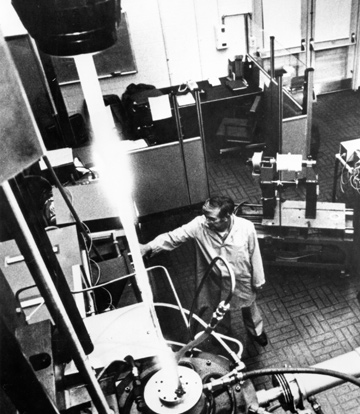 Fiber being drawn from a preform in a pilot production facility at the AT&T Atlanta works by technician Mike Hyle, circa 1977. The preform is heated at the top to soften it, and the molten glass is drawn from the bottom, where it cools and is wound onto a spool. [Bell Laboratories / Alcatel-Lucent USA Inc., courtesy of AIP Emilio Segrè Visual Archives, Physics Today Collection]
Fiber being drawn from a preform in a pilot production facility at the AT&T Atlanta works by technician Mike Hyle, circa 1977. The preform is heated at the top to soften it, and the molten glass is drawn from the bottom, where it cools and is wound onto a spool. [Bell Laboratories / Alcatel-Lucent USA Inc., courtesy of AIP Emilio Segrè Visual Archives, Physics Today Collection]
Keck hauled each preform to Zimar’s lab, where the two mounted it on the furnace and began drawing fiber. Keck then snipped off a length of freshly drawn fiber and took it back to his lab to measure its optical properties—after which he went back to adjust the draw furnace, snip off another length and make more measurements. Later Keck went over the results with Schultz, while Maurer planned and strategized for the unit.
It could take three months from start of a new preform to final results. When the furnace was running in Zimar’s lab during summer 1969, Keck recalls, “it was hotter than Hades.” Yet the team kept working, measuring and learning. They analyzed data to decide the best titanium concentration in fiber cores. Rolling fresh-drawn fibers of various sizes onto drums showed that 50-μm fibers stuck and 250-µm fibers broke, so Keck decided 125 µm was just right—and it remains a standard size today.
Corning said nothing to outsiders, and kept its edge in glass technology by writing and enforcing patents and keeping other technology proprietary. By early 1970, Corning decided its fiber technology was worth patenting, and on 11 May 1970 it filed two applications. The first—“Fused silica optical waveguide,” by Maurer and Schultz—was for a fiber with a pure silica cladding and a doped silica core. The second—“Method of producing optical waveguide fibers,” by Keck and Schultz—covered what became known as the inside vapor deposition (IVD) process.
“Whoopee!”
Keck and Zimar drew fibers from six titanium-doped preforms of various composition on 22 July 1970. After the first fiber was heat-treated on 7 August, Keck tested a 29-m length that had broken off. Its loss was the lowest yet, 17 dB/km, so after he recorded the number in his notebook, Keck wrote “Whoopee!”
The short length of the fiber limited accuracy, so Keck carefully added, “must remeasure.” Then he went into the hall to find someone to share his success, only to see that the place was empty because it was after 5 p.m. on a Friday. As he looked around, an elevator door opened, and the 29-year-old Keck recognized the lab’s director, Armistead, and buttonholed him with the news.
 Equipment used to make preforms for the first sub-20-dB/km optical fibers by inside vapor deposition. A burner produces glass soot, deposited onto the inside surface of a rotating silica glass tube held by the lathe head at upper right. The soot becomes the fiber core and the tube becomes the cladding. Vacuum cleaner that pulls the soot through the tube is not shown. [Courtesy of Corning Inc.]
Equipment used to make preforms for the first sub-20-dB/km optical fibers by inside vapor deposition. A burner produces glass soot, deposited onto the inside surface of a rotating silica glass tube held by the lathe head at upper right. The soot becomes the fiber core and the tube becomes the cladding. Vacuum cleaner that pulls the soot through the tube is not shown. [Courtesy of Corning Inc.]
On 21 August, Keck successfully heat-treated 210 m from the same fiber, enough to give more accurate results. As he was setting up for the measurement, he was surprised to see a very bright red flash when his helium-neon laser entered the fiber core. Eventually he realized it was Fresnel reflection from the far end of the fiber. He recorded a loss measurement of 16.9 dB/km and added the logician’s conclusion “QED” for the validation of the earlier measurement. He still wishes he had thought to add a properly scientific “Eureka!”
Going public
Keck and Maurer had already written a paper on their fiber work, focusing on bending and intrinsic losses in several hundred meters of earlier single-mode fibers with losses of 60–70 dB/km to avoid questions about materials and fiber processing. They added mention of a fiber with “approximately 20 dB/km” of loss before it appeared in the 15 November issue of Applied Physics Letters. Maurer also shared that number with Stewart Miller, head of the waveguide communications group at Bell Labs, with whom he was in regular contact because Corning and Bell had cross-licensed patents.
At the end of September 1970, Maurer flew to London to announce the news at the “Trunk Telecommunications by Guided Waves” meeting sponsored by the U.K. Institution of Electrical Engineers. It was mostly about buried two-inch microwave waveguides, which the telephone industry expected to be the next generation of long-distance line (though Maurer’s was not the only fiber paper). He said nothing about the breakthrough fiber beyond its attenuation, but he did cite a more precise number, 16 dB/km. He was surprised that Bell and other potential competitors had little similar progress to report.
Although Maurer disclosed nothing about the material in Corning’s record-setting fiber, he was glad to accept invitations from both the Post Office and Standard Telecommunications Laboratories to measure the fiber. The Post Office was a potential customer, and both had well-equipped laboratories that could independently verify the low loss. He soon returned to London with the precious fiber in a custom-built container, for which he bought a seat on the plane.
The Post Office lab measured a loss of 15 dB/km, which much impressed the researchers. But their testing procedure worried Maurer because it required snipping off bits of fiber. He tried to catch each piece and tape it down safely, but he missed one and couldn’t find it despite searching the floor. After Maurer left, the Post Office researchers stopped everything until they found the distinctively curved Corning fiber. They thought neutron activation analysis at British Titan Products would reveal the secret ingredient, but it detected only pure silica.
Corning was lucky. British Titan was in the titanium business—and its lab was so contaminated with the stuff that it could not detect the small amount in the Corning fiber.
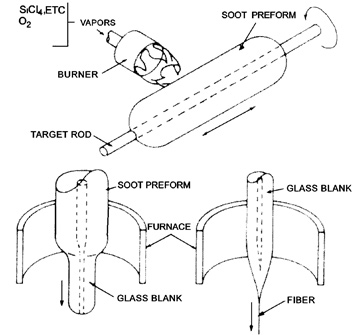 Schematic of the outside vapor deposition process, from a 2000 paper by Donald Keck. [D. Keck, IEEE J. Sel. Top. Quant. Elect. 6, 1254 (2000)]
Schematic of the outside vapor deposition process, from a 2000 paper by Donald Keck. [D. Keck, IEEE J. Sel. Top. Quant. Elect. 6, 1254 (2000)]
Toward practical fibers
The first low-loss fiber was a brilliant success as a proof of principle. But further experiments had failed to produce titanium-doped fibers strong enough to be usable. And the problem lay in the titanium itself.
Heating titania (TiO2) to high temperatures causes it to lose oxygen and become TiO, changing its valence state so it absorbs light in the fiber transmission band. Heat-treating titanium-doped fibers in oxygen converts the TiO back to TiO2. At high temperatures, however, oxygen also interacts with the silica cladding to generate crystals of cristobalite, which weaken the fiber. Hydrofluoric acid can etch away cristobalite, but it is nasty stuff.
Zimar’s boss, John Frazer, urged Schultz to find another dopant that would be less troublesome in production. Germanium looked promising, because germania (GeO2) is a glass-forming compound that mixes mix well with silica, but it evaporates at the high temperatures of the flame hydrolysis process used for IVD.
Meanwhile a separate problem had emerged. Bell Labs had shifted its plans for optical communications to multimode graded-index fibers. Bell’s main interest in fiber optics in the early 1970s was transporting tens of digitized telephone conversations per fiber about 10 km apart, and it decided that LED light sources and multimode fibers would suffice. Coupling light into the few-micrometer cores of single-mode fibers posed a major problem; Bell’s plan was to couple light from special LEDs made to match the 50-µm cores of its version of graded-index fibers.
Corning had known about Bell’s interest in multimode fibers before its low-loss breakthrough. In fact, the company had drawn multimode titanium-doped fibers from preforms made with its IVD process at the same time they produced the record-setting single-mode fibers. The need to produce fibers doped with germanium, combined with the need to produce fibers with much more core material, led to a new flame hydrolysis process—outside vapor deposition (OVD)—matched to those needs.
Fifty years after the first low-loss fiber, fiber optic cables on the ocean floor can now carry 24 terabits per second through a single fiber for more than 10,000 kilometers.
Instead of depositing a small amount of core material inside a tube, OVD deposits soot, one layer at a time, on the outside of a rotating ceramic “bait rod,” starting with the center of the core and working outward. The blend of chemicals being oxidized can be changed between layers to produce a graded refractive index in the core, and a constant, lower index in the cladding.
The ceramic rod then is removed, and the preform heated to 1350 °C in helium gas to melt the soot down into a solid glass preform. Finally the layered preform is heated to draw into fibers with graded properties, such as the refractive index in graded-index fibers. The temperature is low enough that it does not cause germanium to evaporate, so it can be used to produce germanium-doped fibers, avoiding the problems the team had suffered with titanium.
Months of work went into developing OVD before the group produced its first multimode preform, doped with 9% germanium in the core, and put it to the test by drawing fiber from it in early June 1972. “We immediately knew that we were on the right track when we could still see the bright light of the draw furnace shining through the end of a kilometer of fiber on the wind-up drum,” Schultz wrote in OPN. “It was one of those shattering moments,” says Keck. He, Schultz and Zimar watched and thought “Oh my God, we got it.”
The need for heat-treating was gone. So was the fear of the fiber becoming so weak that it would break if touched. The fiber looked clear right out of the furnace.
A hurricane, then triumph
Disaster struck a week after the new breakthrough. Hurricane Agnes curved west from the Atlantic across western New York state. Though its winds were below hurricane strength when it passed through the Corning area, the storm drenched the region with up to 20 inches of water. The Corning research center sat safe on a hill, but the city of Corning was flooded, the company shut down, and employees spent weeks helping residents.
 Peter Schultz using outside vapor deposition to make a germania-doped multimode fiber preform, circa 1972. Soot is deposited layer by layer onto a rotating thin bait rod that moves back and forth in front of the flame hydrolysis burner. [Courtesy of Corning Inc.]
Peter Schultz using outside vapor deposition to make a germania-doped multimode fiber preform, circa 1972. Soot is deposited layer by layer onto a rotating thin bait rod that moves back and forth in front of the flame hydrolysis burner. [Courtesy of Corning Inc.]
Schultz was working on the cleanup when he encountered Armistead, who greeted him, “Pete, that’s fantastic! You really did it.” Schultz was impressed to have top management recognize his achievement, and realized “This thing is serious.”
When the mud and mess were gone, the fiber research group returned to their labs. Careful measurements showed that the germanium-doped fiber had minimum loss of 4 dB/km between 800 and 850 nm. They found that hydroxyl absorption caused most of the loss between 700 and 1100 nm. Reducing that absorption could bring total attenuation down to 2 dB/km, Keck, Maurer and Schultz wrote in a paper titled “On the ultimate lower limit of attenuation in glass optical waveguides.”
“This was, to my mind, the breakthrough for fiber optics, because it was now a practical fiber,” Schultz recalled. “It didn’t break, you didn’t have to go through all this other stuff. You could make fibers right off the draw with these nice low losses.” It was a technological triumph for Maurer’s contrarian strategy. He chose something different from the others because he wanted to win, not tie. He played to Corning’s strength in glass science and its experience with fused silica, and he built a strong team of gifted people to make it happen.
It was not clear sailing afterwards, however. The economic slump of the early 1970s hit Corning hard. Chuck Lucy, who managed Corning’s bundled-fiber business, traveled around the world hammering out several joint development agreements. Those pacts helped communication companies learn about fiber as Corning learned about communications, and brought in vital funding. Amory Houghton, Corning’s chairman and CEO, supported the fiber program through tough times so it could grow.
Decades of growth
Fiber technology was on a roll. It started in the 700 to 1100 nm window, because that was where the GaAs LEDs and lasers were. Longer infrared windows opened quickly and new sources emerged. In 1978, Nippon Telegraph and Telephone reported loss of 0.2 dB/km at 1550 nm, close to the theoretical limit from scattering.
Today, more than 40 years later, germanium-doped fibers remain the industry standard, with billions of kilometers deployed. The loss in mass-produced single-mode fiber is now only 0.17 dB/km—almost all due to scattering at the fundamental limit. Bandwidth has exploded with advances in laser transmitters, optical amplifiers, wavelength-division multiplexing and coherent transmission. Fifty years after the first low-loss fiber, fiber optic cables on the ocean floor can now carry 24 terabits per second through a single fiber for more than 10,000 kilometers. It’s one of the most amazing technological achievements of the past half century.
Jeff Hecht is an OSA Fellow and freelance writer who covers science and technology.
This article draws partly on research for the author’s previously published book City of Light: The Story of Fiber Optics (Oxford, 1999 and 2004). Additional references and resources are at www.osa-opn.org/link/low-loss-fiber.

